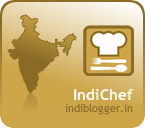The charm of being a true blue Delhi resident is the exposure one has to chaat ...different kinds of chaat. Chaat derives its name from the hindi word 'Chaatna', literally meaning licking ones fingers. Since most of the chaat items ensure you will end up licking your fingers, the name is very apt. Chaat has now spread its tentacles to various parts othe country and it is not uncommon to find chaat stalls in South India, where they hawk something called a Delhi Chaat. The key differentiators of all chaats boils down to the use of ingredients and their freshness. The freshness of yogurt used, the freshness of the spices, the crispness of the papdi, the freshness of the fruit ...the freshness.
I was in Old Delhi last to last Saturday to sample the chaat fare on offer and try out the kulle ki chaat which sadly is not commonly available, atleast, not in the area I'm in. I love my chaats and my better half more than me, but we had both never had a kulle ki chaat ever. So it was a pleasant experience and the glee on both our faces while we were sampling this was a moment to freeze.
Post my return back home, I knew this was one chaat I had to do for this blog. More than that, this was one for keeps as a great appetizer for parties. It's simple, fresh and so different. The first challenge was to source the variety of bengal gram used in the chaat. Since, it is not used in the chaats in my area, I had to request someone to get it from me from Khari Baoli. Next was the conceptualization. For kulle ki chaat, you need to make a kulla out of Potatoes, cucumber, chunk of watermelon, bananas,tomatoes and then fill them and spice them. Kulla is a scooped out vegetable or fruit. I used only three, Watermelon, Potato and Cucumber, despite protests from my better half to use bananas as she loved the banana ka kulla. The result was the same expression on both our face as we had our plate of watermelon, potato and cucumber ka kulla and enjoyed a wonderful Noida sunset from our rooftop.
Kulle Ki Chaat
(For 4 People)
Ingredients
Potatoes,big - 2
Watermelon, seedless (I didn't get one) - 1
Cucumber - 2
Cumin - 3 Tblsp
Black Salt - 2 Tblsp
Salt - To Taste
Lemon - 2
Bengal Gram, the zero size variety (soaked overnight and boiled) - 1/2 Cup
Pomegranate seeds - 1 Cup
For the Masala (alternately, use 3 Tblsp chaat masala)
Black Pepper Corns - 2 Tsp
Cloves - 4
Cinnamon Stick - 1
Mango Powder - 3 Tsp
Ginger Powder - 1 Tsp
Ajwain - 1/2 Tsp
Dry Mint Leaves - 1/2 Tsp
Method:
1. Parboil the potatoes and peel and cut them into half (breadthwise). Scoop out the middle to make a empty barrel.
2. Peel the cucumber and cut into 4 inch pieces. Hollow them out too.
3. Take a small chunk of watermelon and hollow it out.
4. Arrange them on a plate.
5. Dry roast the ingredients for the masala and powder them.
6. Dry roast the cumin seeds and powder them with a mortar and pestle.
7. Sprinkle half the salt, black salt, cumin powder, chaat masala on the hollowed cups.
8. Add the pomegranate and bengal grams and fill the cups till they are half full.
9. Sprinkle the rest of the salt, black salt, cumin powder, chaat masala.
10. Squeeze lemon juice on the cups.
11. The chaat is ready to go.













 Monday, September 26, 2011
Monday, September 26, 2011
 Gaurav
Gaurav

























